Strength and Stiffness Evaluation of a Fiber-Reinforced Cement-Stabilized Fly Ash Stone Dust Aggregate Mixture
Abstract
:1. Introduction
2. Materials and Methods
2.1. Materials
2.1.1. Fly Ash
2.1.2. Cement
2.1.3. Stone Dust and Crushed Stone Aggregates
2.1.4. Polypropylene Fiber (Randomly Oriented)
2.1.5. Mix Proportioning
2.2. Experimental Programme
2.2.1. Sample Preparation
2.2.2. Unconfined Compressive Strength Test (UCS)
2.2.3. Indirect Tensile Test (IDT)

2.2.4. Flexure Test

3. Results
3.1. Compressive Strength
3.1.1. Effect of Fiber on the UCS Value
3.1.2. Effect of Fiber on the Stress–Strain Relationship
3.1.3. Indirect Tensile Strength (ITS)
3.1.4. Correlation between the ITS and UCS
3.2. Flexural Strength (FS)
3.2.1. Effect of Fiber on Flexural Strength
3.2.2. Relationship between FS, UCS, and ITS (7 Days or 28 Days)
3.3. Cyclic Indirect Tensile Modulus/Resilient Modulus (IDTM)
Effect of Fiber on IDTM
3.4. Flexural Modulus
3.4.1. Effect of Fiber on Flexural Modulus
3.4.2. Relationship between Flexural Modulus and Flexural Strength
4. Summary and Conclusions
5. Limitation
6. Future Scope of Study
Author Contributions
Funding
Data Availability Statement
Conflicts of Interest
References
- CEA. Report on Fly Ash Generation at Coal/Lignite Based Thermal Power Stations and Its Utilization in the Country for the Year 2021–22. Available online: http://www.cea.nic.in (accessed on 24 April 2023).
- Zabielska-Adamska, K. Laboratory Compaction of Fly Ash and Fly Ash with Cement Additions. J. Hazard. Mater. 2008, 151, 481–489. [Google Scholar] [CrossRef] [PubMed]
- Šešlija, M.; Rosić, A.; Radović, N.; Vasić, M.; Đogo, M.; Jotić, M. Laboratory testing of fly ash. Tech. Gaz. 2016, 23, 1839–1848. [Google Scholar] [CrossRef]
- Lav, A.H.; Lav, M.A.; Göktepe, A.B. Analysis and Design of a Stabilized Fly Ash as Pavement Base Material. Fuel 2006, 85, 2359–2370. [Google Scholar] [CrossRef]
- Kumar, M.A.; Prasad, D.S.V.; Raju, G.P. Performance Evaluation of stabilized fly ash subbases. J. Eng. Appl. Sci. 2010, 5, 50–57. [Google Scholar]
- Patil, N.R.; Kulkarni, D.; Talegaonkar, S.D. Economical Pavement Design by Stabilizing Effect of Fly Ash and Lime. Indian J. Res. 2012, 2, 121–124. [Google Scholar] [CrossRef]
- Amhadi, T.; Assaf, G.J. Improvement of Pavement Subgrade by Adding Cement and Fly Ash to Natural Desert Sand. Infrastructures 2021, 6, 151. [Google Scholar] [CrossRef]
- Kelechi, S.E.; Adamu, M.; Uche, O.A.U.; Okokpujie, I.P.; Ibrahim, Y.E.; Obianyo, I.I. A Comprehensive Review on Coal Fly Ash and Its Application in the Construction Industry. Cogent Eng. 2022, 9, 2114201. [Google Scholar] [CrossRef]
- Shahu, J.T.; Patel, S.J.; Senapati, A.K. Engineering Properties of Copper Slag–Fly Ash–Dolime Mix and Its Utilization in the Base Course of Flexible Pavements. J. Mater. Civ. Eng. 2013, 25, 1871–1879. [Google Scholar] [CrossRef]
- Bakare, M.D.; Pai, R.R.; Patel, S.; Shahu, J.T. Environmental Sustainability by Bulk Utilization of Fly Ash and GBFS as Road Subbase Materials. J. Hazard. Toxic Radioact. Waste 2019, 23, 04019011. [Google Scholar] [CrossRef]
- Pai, R.R.; Bakare, M.D.; Patel, S.J.; Shahu, J.T. Structural Evaluation of Flexible Pavement Constructed with Steel Slag–Fly Ash–Lime Mix in the Base Layer. J. Mater. Civ. Eng. 2021, 33, 04021097. [Google Scholar] [CrossRef]
- Usmen, M.; Bowders, J.J. Stabilization Characteristics of Class F Fly Ash. Transp. Res. Rec. 1990, 1288, 59–69. [Google Scholar]
- Ghosh, A.; Subbarao, C. Strength Characteristics of Class F Fly Ash Modified with Lime and Gypsum. J. Geotech. Geoenviron. Eng. 2007, 133, 757–766. [Google Scholar] [CrossRef]
- Dimter, S.; Rukavina, T.; Barišić, I. Application of the Ultrasonic Method in Evaluation of Properties of Stabilized Mixes. Baltic J. Road Bridge Eng. 2011, 6, 177–184. [Google Scholar] [CrossRef]
- Kaniraj, S.R.; Havanagi, V.G. Behavior of Cement-Stabilized Fiber-Reinforced Fly Ash-Soil Mixtures. J. Geotech. Geoenviron. Eng. 2001, 127, 574–584. [Google Scholar] [CrossRef]
- Kumar, P.; Singh, S.P. Fiber-Reinforced Fly ash Subbases in rural Roads. J. Transp. Eng. 2008, 134, 171–180. [Google Scholar] [CrossRef]
- Vaidya, M.K.; Chore, H.S.; Kousitha, P.; Ukrande, S.K. Geotechnical characterization cement-fly ash-fiber mix. J. Mech. Civ. Eng. 2015, 1, 60–66. [Google Scholar]
- Li, L.; Zhang, J.; Xiao, H.; Zhi, H.; Wang, Z. Experimental Investigation of Mechanical Behaviors of Fiber-Reinforced Fly Ash-Soil Mixture. Adv. Mater. Sci. Eng. 2019, 2019, 1050536. [Google Scholar] [CrossRef]
- Pasupuleti, V.K.R.; Kolluru, S.K.; Blessingstone, T. Effect of Fiber on Fly-Ash Stabilized Sub Grade Layer Thickness. Int. J. Eng. Technol. 2012, 4, 140–147. [Google Scholar]
- Chakrabarti, S.; Kodikara, J. Basaltic crushed rock stabilized with cementitious additives: Compressive strength and stiffness, drying shrinkage, and capillary flow characteristics. Transp. Res. Rec. J. Transp. Res. Board 2003, 1819, 18–26. [Google Scholar] [CrossRef]
- Paige-Green, P. Recent developments in soil stabilization. In Proceedings of the 19thARRB Transport Research Ltd Conference Sydney, New South Wales, Australia, 7–11 December 1998. [Google Scholar]
- Yeo, R.; Jitsangiam, P.; Nikraz, H. Mix Design of Cementitious Basecourse. In Proceedings of the International Conference on Advances in Geotechnical Engineering (ICAGE 2011), Perth, Australia, 7–9 November 2011. [Google Scholar]
- Biswal, D.R.; Sahoo, U.C.; Dash, S.R. Mechanical characteristics of cement stabilised granular lateritic soils for use as structural layer of pavement. Road Mater. Pavement Des. 2020, 21, 1201–1223. [Google Scholar] [CrossRef]
- Wen, H.; Muhunthan, B.; Wang, J.; Li, X.; Edil, T.; Tinjum, J.M. Characterization of Cementitiously Stabilized Layers for Use in Pavement Design and Analysis; NCHRP Report No. 789, Transportation Research Board: Washington, DC, USA, 2014. [Google Scholar]
- ASTM C618; Standard Specification for Coal Fly Ash and Raw or Calcined Natural Pozzolan for Use in Concrete. ASTM International: West Conshohocken, PA, USA, 2022.
- IS 8112; Ordinary Portland Cement, 43 Grade—Specification (Second Revision). BIS: New Delhi, India, 2003.
- ASTM D1557-12; Standard Test Methods for Laboratory Compaction Characteristics of Soil Using Modified Effort (56,000 ft-lbf/ft3 (2,700 kN-m/m3)). ASTM International: West Conshohocken, PA, USA, 2021.
- ASTM D1633; Standard Test Methods for Compressive Strength of Molded Soil-Cement Cylinders. ASTM International: West Conshohocken, PA, USA, 2017.
- Yeo, R. The Development and Evaluation of Protocols for the Laboratory characterisation of Cemented Materials; Austroads Publication No. AP–T101/08, ARRB-Australia: Melbourne, Australia, 2008. [Google Scholar]
- ASTM D1635; Standard Test Method for Flexural Strength of Soil-Cement Using Simple Beam with Third-Point Loading. ASTM International: West Conshohocken, PA, USA, 2006.
- IRC SP:89; Guidelines for the Design of Stabilized Pavement (Part I). IRC: New Delhi, India, 2010.
- Arabani, M.; Haghsheno, H. The effect of polymeric fibers on the mechanical properties of cement-stabilized clay soils in Northern Iran. Int. J. Geotech. Eng. 2020, 14, 557–568. [Google Scholar] [CrossRef]
- Wang, H.S.; Tang, C.S.; Gu, K.; Shi, B.; Inyang, H.I. Mechanical behavior of fiber-reinforced, chemically stabilized dredged sludge. Bull. Eng. Geol. Environ. 2020, 79, 629–643. [Google Scholar] [CrossRef]
- Haghighatjoo, S.M.; Zolfegharifar, S.Y. Effects of fiber type and content on unconfined compressive strength of fiber-reinforced lime or cement-stabilised soils. Geomech. Geoengin. 2022, 17, 1962–1972. [Google Scholar] [CrossRef]
- Tang, C.S.; Wang, D.Y.; Cui, Y.J.; Shi, B.; Li, J. Tensile strength of fiber-reinforced soil. J. Mater. Civ. Eng. 2016, 28, 04016031. [Google Scholar] [CrossRef]
- Festugato, L.; da Silva, A.P.; Diambra, A.; Consoli, N.C.; Ibraim, E. Modelling tensile/compressive strength ratio of fiber reinforced cemented soils. Geotext. Geomembr. 2018, 46, 155–165. [Google Scholar] [CrossRef]
- Mandal, T.; Edil, T.B.; Tinjum, J.M. Study on flexural strength, modulus, and fatigue cracking of cementitiously stabilised materials. Road Mater. Pavement Des. 2008, 19, 1546–1562. [Google Scholar] [CrossRef]

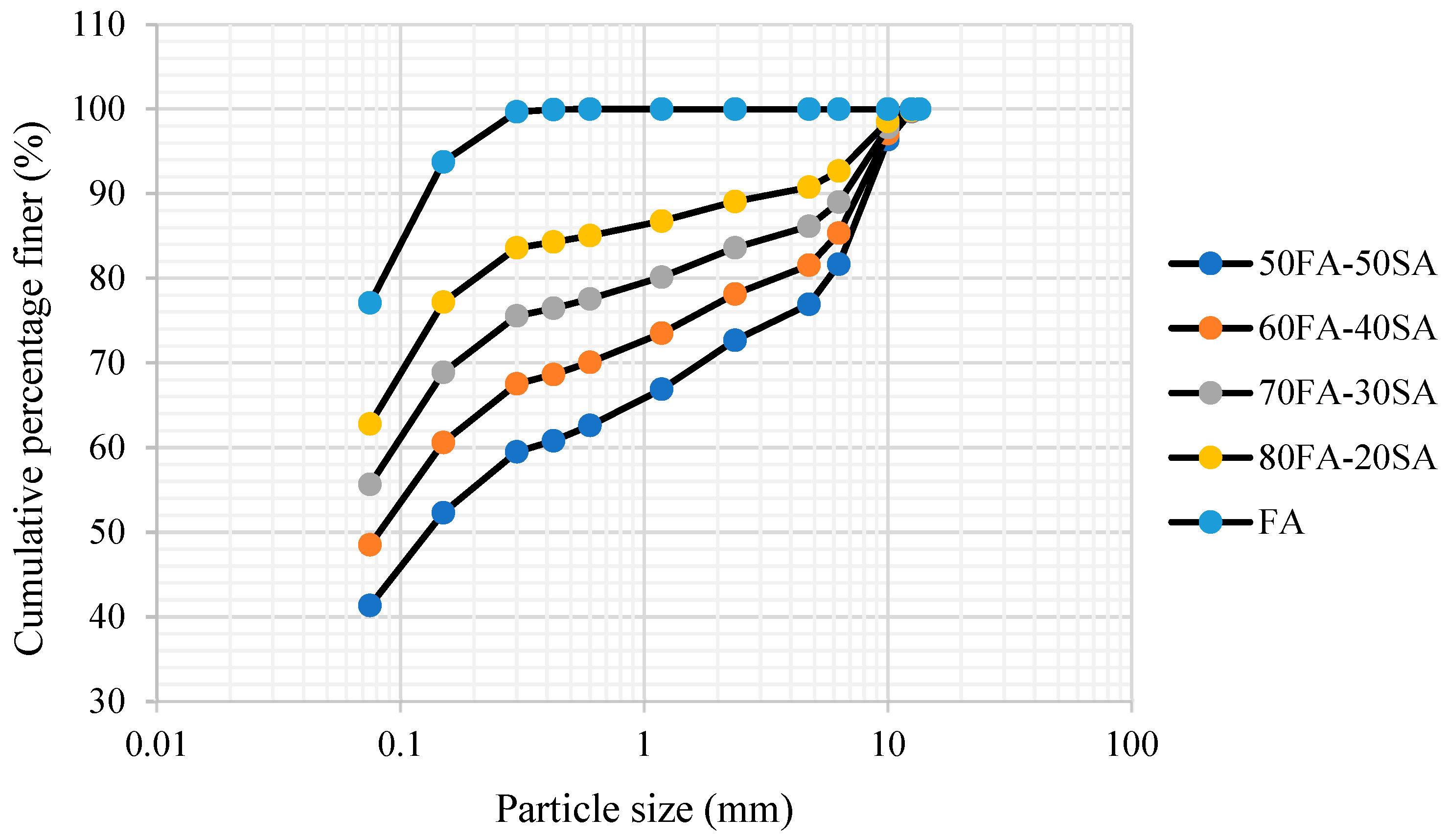
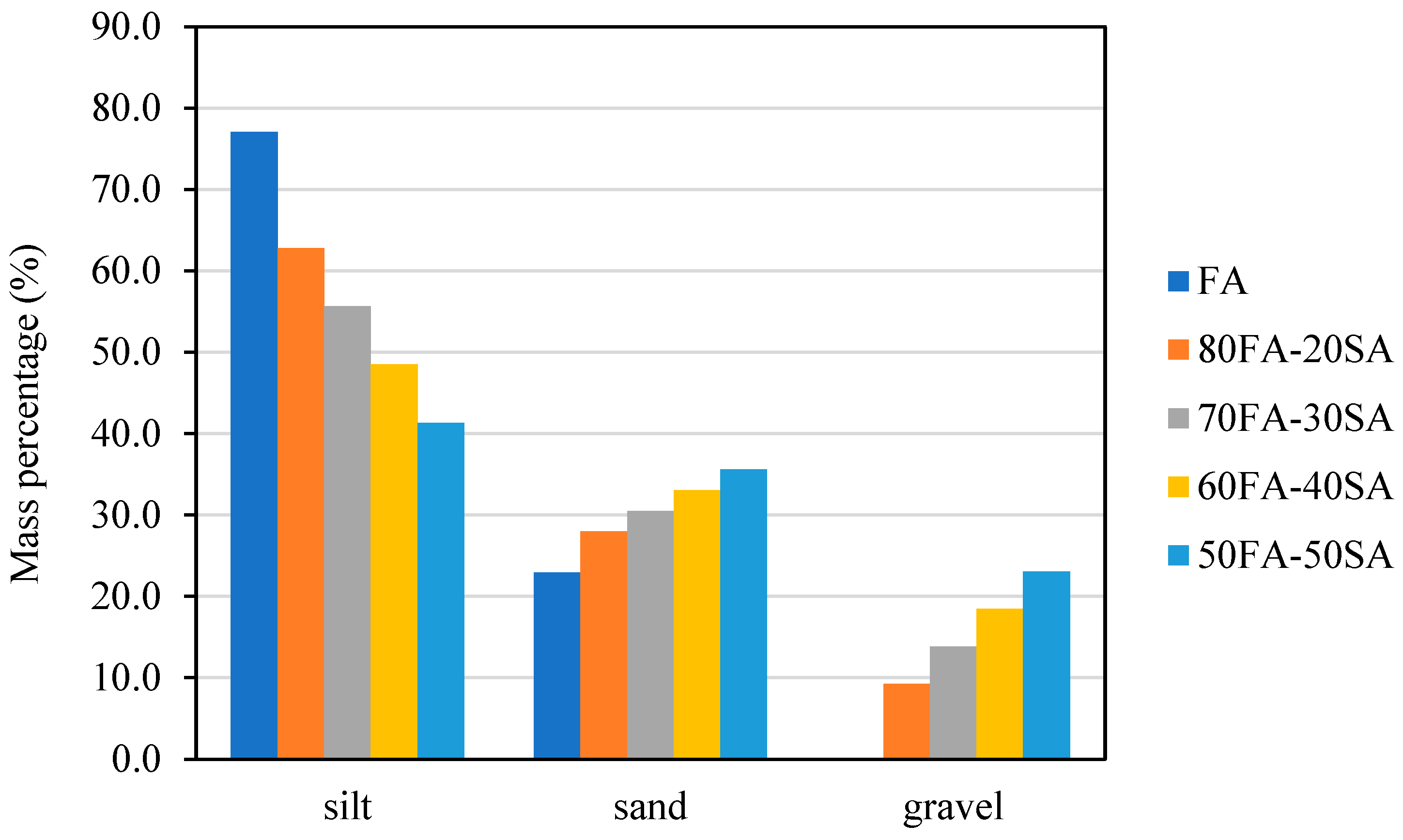
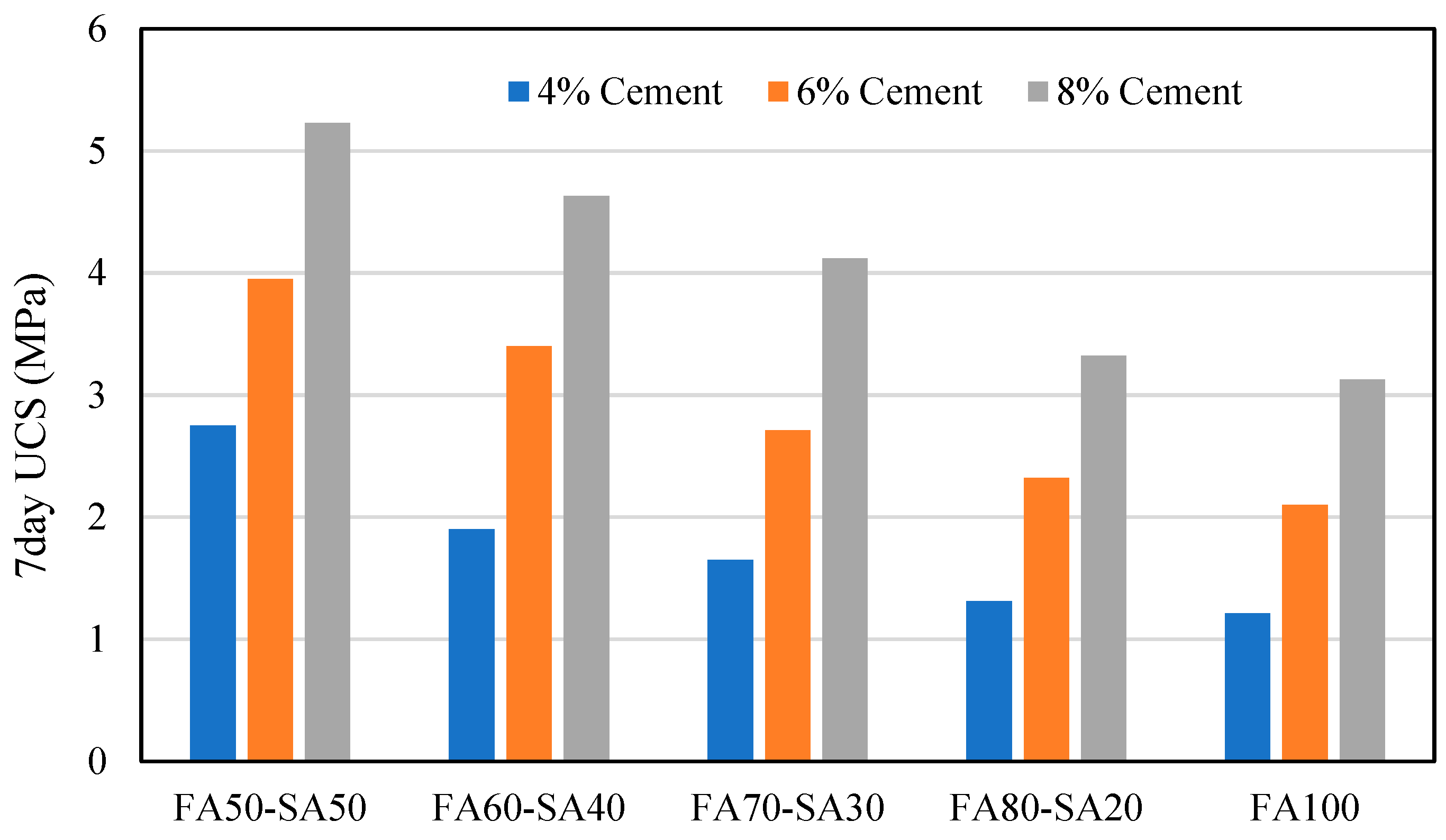
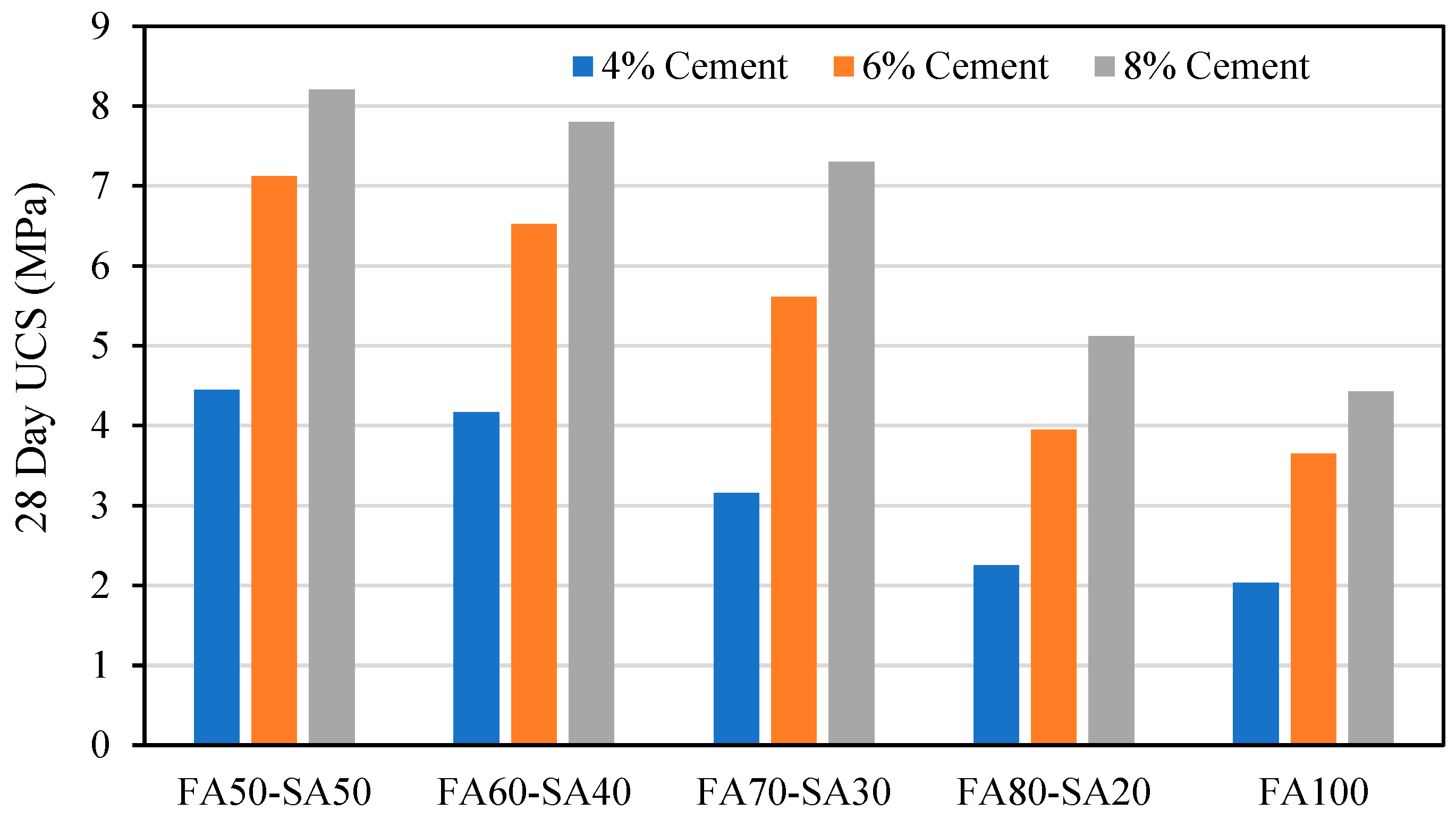



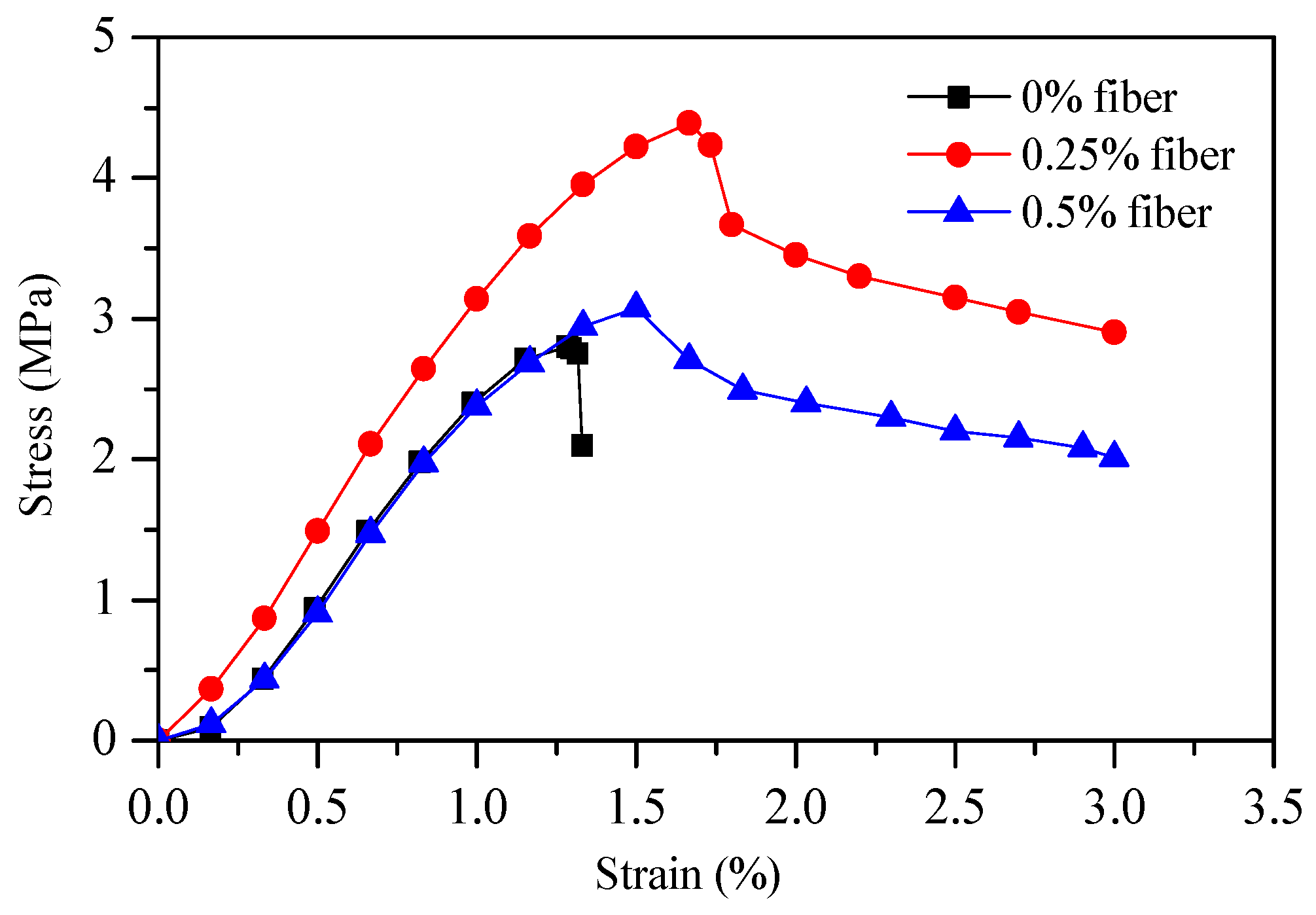












| Sl No. | Chemical Components | Percentage by Weight (%) |
|---|---|---|
| 1 | SiO2 | 61.34 |
| 2 | Al2O3 | 29.54 |
| 3 | Fe2O3 | 4.89 |
| 4 | CaO | 1.05 |
| 5 | MgO | 0.56 |
| 6 | Na2O | 0.1 |
| 7 | K2O | 0.25 |
| 8 | TiO2 | 0.67 |
| 9 | P2O5 | 0.1 |
| 10 | LOI (Loss on Ignition) | 1.1 |
| Properties | Value |
|---|---|
| Material | 100% Virgin Polypropylene (PP) |
| Length | 12.0 +/− 0.25 Mm |
| Diameter | 24 Micron (Approx.) |
| Aspect Ratio | 500 (Approx.) |
| Melting Point | 162 °C |
| Specific Gravity | 0.91 |
| Thermal/Electrical Conductivity | Low |
| Alkali Resistance | 100% Alkali Proof |
Disclaimer/Publisher’s Note: The statements, opinions and data contained in all publications are solely those of the individual author(s) and contributor(s) and not of MDPI and/or the editor(s). MDPI and/or the editor(s) disclaim responsibility for any injury to people or property resulting from any ideas, methods, instructions or products referred to in the content. |
© 2023 by the authors. Licensee MDPI, Basel, Switzerland. This article is an open access article distributed under the terms and conditions of the Creative Commons Attribution (CC BY) license (https://creativecommons.org/licenses/by/4.0/).
Share and Cite
Mohanty, S.K.; Biswal, D.R.; Mohapatra, B.G.; Beriha, B.; Pradhan, R.; Sutar, H. Strength and Stiffness Evaluation of a Fiber-Reinforced Cement-Stabilized Fly Ash Stone Dust Aggregate Mixture. J. Compos. Sci. 2023, 7, 459. https://doi.org/10.3390/jcs7110459
Mohanty SK, Biswal DR, Mohapatra BG, Beriha B, Pradhan R, Sutar H. Strength and Stiffness Evaluation of a Fiber-Reinforced Cement-Stabilized Fly Ash Stone Dust Aggregate Mixture. Journal of Composites Science. 2023; 7(11):459. https://doi.org/10.3390/jcs7110459
Chicago/Turabian StyleMohanty, Sanjeeb Kumar, Dipti Ranjan Biswal, Benu Gopal Mohapatra, Brundaban Beriha, Ramachandra Pradhan, and Harekrushna Sutar. 2023. "Strength and Stiffness Evaluation of a Fiber-Reinforced Cement-Stabilized Fly Ash Stone Dust Aggregate Mixture" Journal of Composites Science 7, no. 11: 459. https://doi.org/10.3390/jcs7110459







